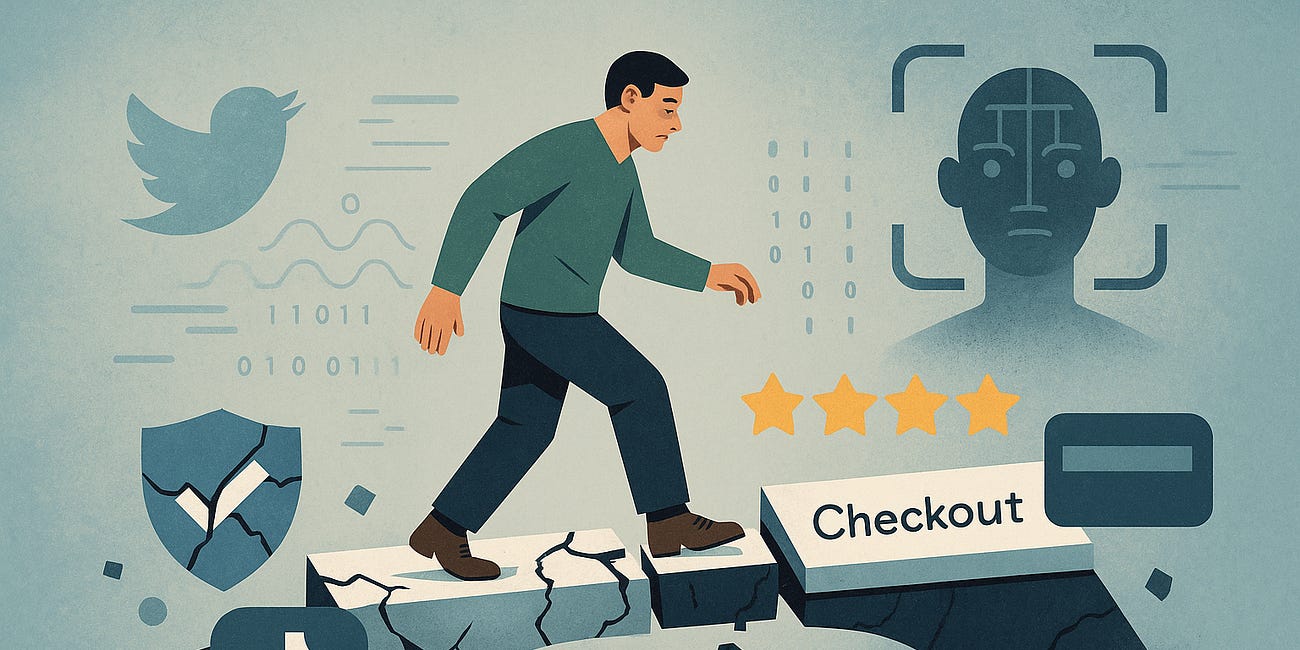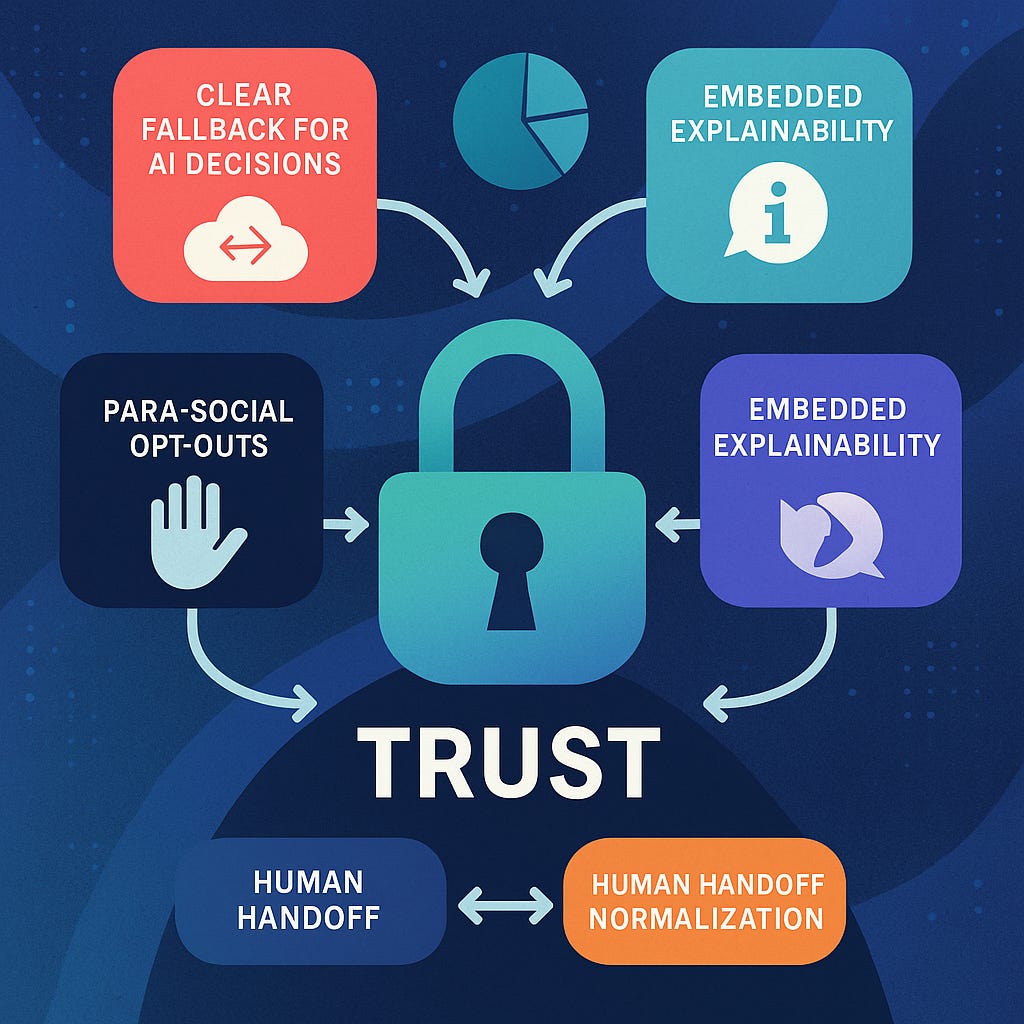Toward a Trust-Centric Tech Future: Rethinking System Design
Trust isn’t a vibe, it’s infrastructure. Explore how ethical systems, AI fallback, and user control must define the next era of technology.
Toward a Trust-Centric Tech Future
Trust is collapsing, not all at once, but system by system.
Not because people are irrational.
Not because they hate change.
But because we built digital systems in an environment that values “move fast and break things,” especially the social contracts that used to signal safety.
Today, the average user is fluent in friction, fluent in betrayal.
They no longer ask “what does this do?” but “what’s the catch?”
They expect:
Automated denial without explanation
Interfaces that prioritize business logic over human clarity
AI decisions that affect their lives and give no rationale
And they’ve learned, through repetition, not rhetoric, that most technology is designed for extraction, not collaboration.
This isn’t a UX problem. It’s a philosophical failure of design imagination.
Because we didn’t stop to ask:
What if trust isn’t just a lubricant for digital systems?
What if it’s the load-bearing architecture?
From "Minimum Viable Product" to "Minimum Viable Trust"
Silicon Valley taught us to value velocity.
To ship. To iterate. To optimize for engagement.
But in that logic, trust became a secondary condition, not a primary constraint.
We learned to ask:
How do we get the user to click?
How do we convert faster?
How do we reduce resistance?
What we didn’t ask is:
What does this system assume about the user?
Where does it expect submission instead of comprehension?
What happens if the user doesn’t trust the process?
That’s the pivot point we’re standing on now.
We can no longer afford to build systems that presume trust.
We have to design for its scarcity.
What Is a Trust-Centric System?
A trust-centric system doesn’t merely perform well.
It aligns its internal logic with ethical legibility and user agency.
It asks:
Does this system behave transparently, even under stress?
Can the user question, challenge, or override decisions?
Does it communicate enough context for a reasonable human to stay in control?
It doesn’t rely on brand voice, friendliness, or clever UX copy.
Because it knows: trust isn’t a tone—it’s a structural condition.
A Framework for Trust-Centric Design
To move toward this future, we need to rewire the foundation, not just redesign the interface. That begins with embedding trust across every layer of interaction and system logic.
1. Clear Fallback for AI Decisions
If AI makes a decision, the system must guarantee:
A rationale the user can inspect
A path to contest or reverse it
A human fallback when needed
The fallback isn’t a workaround—it’s the integrity buffer.
The guarantee that automation doesn’t become authoritarianism.
2. User-Controlled Data Trails
Trust dies when data disappears into a black box.
We need:
Clear visibility into what’s been collected
Control over how it’s used
A means to delete or revoke that data at any time, without a labyrinth of friction
This isn’t just privacy.
It’s data sovereignty as a trust signal.
3. Embedded Explainability
Every system action should be accompanied by a short answer to:
“Why did this happen?”
That doesn’t mean burying technical documentation.
It means layering contextual explainability into the product flow, where the user needs it most.
If a decision affects their access, status, pricing, or identity?
They deserve to understand the model behind it.
4. Para-Social Opt-Outs
Not every transaction should require emotional buy-in.
Too many systems now weaponize para-social intimacy—using influencer familiarity or AI personas to mask transactional motives.
A trust-centric platform should offer:
Straightforward, relationship-free pathways
Clear labels when emotional design is in play
An option to “Just Buy” without the song and dance
Because emotional consent is still consent, and users have the right to withhold it.
5. Human Handoff Normalization
When the machine can’t resolve it, the user should be able to:
Get to a human quickly
Understand who that human is authorized to be
Expect empathy paired with decision-making power
Humans aren’t just safety nets.
They’re trust repair agents, especially when digital systems fail, glitch, or harm.
This requires staffing, training, and permission, not just escalation tickets.
Trust Is Not Sentiment. It’s Structure.
Here’s the philosophical turn:
We’ve treated trust as something fuzzy.
As something earned through branding, tone, and loyalty perks.
But trust is not a vibe.
It’s a signal of systemic coherence.
Does this system do what it says?
Does it treat me like a participant, not a pawn?
When things go wrong, does it respect my ability to reason through it?
That’s not sentiment. That’s civic architecture.
And in a trust-centric tech future, that architecture becomes the product.
Final Thought: Trust Is Not the Feature. It Is the Product.
If trust is a button, a badge, or a page in the footer, you’re already too late.
If it’s a strategy layered into every interaction, every override, every moment of conflict, you’re building something more than software.
You’re building a future people can participate in without fear.
That’s what we mean by trust-centric.
And that’s the only kind of tech future worth building.
Go back to the beginning:
Trust, Interrupted: How Modern UX and AI Are Breaking, and Remaking Buyer Confidence
The Trust Buyer Persona: A New Decision-Maker



